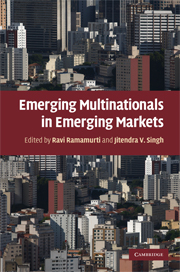Book contents
- Frontmatter
- Contents
- List of figures
- List of tables
- List of abbreviations
- List of contributors
- Acknowledgments
- Part I Introduction
- Part II Country Studies
- 5 Chinese multinationals: Emerging through new global gateways
- 6 Indian multinationals: Generic internationalization strategies
- 7 Russian multinationals: Natural resource champions
- 8 Brazilian multinationals: Surfing the waves of internationalization
- 9 South African multinationals: Building on a unique legacy
- 10 Mexican multinationals: Insights from CEMEX
- 11 Thai multinationals: Entering the big league
- 12 Israeli multinationals: Competing from a small open economy
- Part III Conclusions
- Index
- References
6 - Indian multinationals: Generic internationalization strategies
from Part II - Country Studies
Published online by Cambridge University Press: 03 July 2009
- Frontmatter
- Contents
- List of figures
- List of tables
- List of abbreviations
- List of contributors
- Acknowledgments
- Part I Introduction
- Part II Country Studies
- 5 Chinese multinationals: Emerging through new global gateways
- 6 Indian multinationals: Generic internationalization strategies
- 7 Russian multinationals: Natural resource champions
- 8 Brazilian multinationals: Surfing the waves of internationalization
- 9 South African multinationals: Building on a unique legacy
- 10 Mexican multinationals: Insights from CEMEX
- 11 Thai multinationals: Entering the big league
- 12 Israeli multinationals: Competing from a small open economy
- Part III Conclusions
- Index
- References
Summary
Indian firms expanded outward in two waves, the first occurring in the 1970s and 1980s, and the second occurring after 1995, shortly after India had opened up to the global economy in 1991 following economic reforms. The second wave was not only bigger in terms of the scale and speed of outward FDI, but the firms involved used a broader range of strategies. One especially interesting feature was that in the second wave 60–70 percent of the outward FDI went “up-market” (i.e., to highly advanced countries), unlike the first wave in which almost the same proportion went “down-market” (i.e., to countries less developed than India; Lall, 1983). In addition, there was some evidence that in 2006 and the first half of 2007, Indian firms may have invested more abroad than foreign MNEs invested in India – a surprising result for a poor country, although the data underlying these claims need more careful sorting out (Dunning and Narula, 1996).
In this chapter, we try to get beneath these intriguing macro outcomes by looking at the underlying micro phenomena at the firm level. Among other questions, we ask: Which Indian firms were at the vanguard of internationalization, and why? What international competitive advantages did they enjoy, and why? How did they internationalize? Which firms directed their investment to the advanced countries, and why? And finally, what impact did Indian firms have on the structure and dynamics of the global industries in which they participated?
- Type
- Chapter
- Information
- Emerging Multinationals in Emerging Markets , pp. 110 - 166Publisher: Cambridge University PressPrint publication year: 2009
References
- 39
- Cited by



